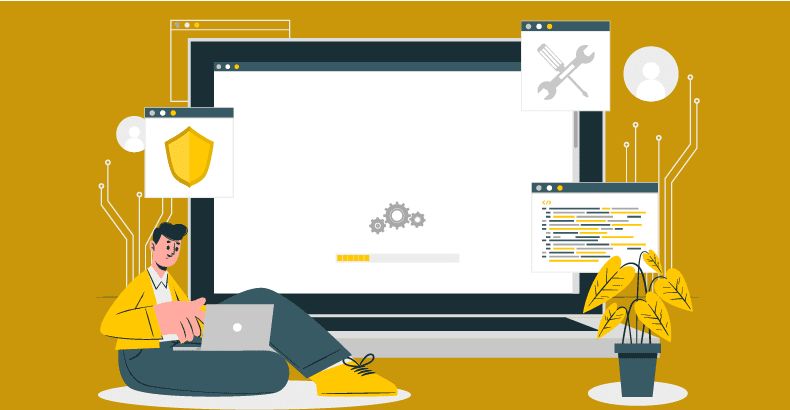Continuous Security Testing: Integrating Protection into DevOps

- October 5, 2023
- admin
Modern software development changes quickly. Companies want to release new ideas fast. DevOps and security testing help blend development and operations. But, security is still very important in this fast environment.
To address this challenge, organizations are turning to Continuous Security Testing, a proactive and automated approach that embeds security measures into the DevOps pipeline. In this article, we will delve into the principles, benefits, and implementation of Continuous Security Testing, highlighting its critical role in safeguarding applications throughout the software development lifecycle.
Understanding the DevOps Paradigm
First, let’s understand DevOps before we talk about Continuous Security Testing. DevOps is a way of working that wants to remove the barriers between development and operations teams. It promotes working together, automating tasks, and combining development, testing, deployment, and operations. Some important DevOps principles are:
Automation
The automation of repetitive tasks, such as building, testing, and deployment, to streamline workflows and reduce manual errors.
Collaboration
Encouraging cross-functional teams to collaborate closely, fostering transparency, and sharing responsibilities.
Continuous Integration (CI)
Integrating code changes frequently, often multiple times a day, to detect and address issues early in the development cycle.
Continuous Delivery
Automating the delivery of software to production environments once it has passed all tests and quality checks.
Monitoring and Feedback
Continuously monitoring application performance, user feedback, and operational metrics to drive ongoing improvements.
While DevOps has revolutionized software development by accelerating the delivery process, it also introduces new challenges, particularly in the realm of security.
The Imperative for Security in DevOps
Traditionally, security came after development, causing delays and costly issues. DevOps, on the other hand, goes for speed and continuous development. So, security needs to adapt to this faster pace.
The key security challenges in DevOps include:
Speed vs. Security
The rapid release cycles of DevOps can lead to security being seen as a bottleneck. Security measures must keep pace with development without sacrificing effectiveness.
Integration
Security practices need to be seamlessly integrated into the DevOps pipeline, ensuring that security testing is automated and does not disrupt the development workflow.
Visibility
Security teams require visibility into the development and deployment process to identify potential vulnerabilities and assess risk.
Scalability
As organizations scale their DevOps initiatives, security testing must scale as well, accommodating the increased velocity of code changes.
Continuous Security Testing: An Overview
Continuous Security Testing (CST) is a proactive method. It adds security checks to the DevOps process. The idea is to have security right from the start and check it regularly during development. CST finds and fixes security problems early, preventing costly issues down the road.
Key components of Continuous Security Testing include:
Automation
CST relies on automated security testing tools and practices to assess applications for vulnerabilities and compliance with security policies.
Integration
Security testing is seamlessly integrated into the DevOps pipeline, ensuring that it becomes an integral part of the development process.
Continuous Feedback
CST provides continuous feedback to development teams, enabling them to address security issues promptly and iterate on secure code.
Risk Assessment
CST not only identifies vulnerabilities but also assesses their impact and potential risk to the organization.
Benefits of Continuous Security Testing
The adoption of Continuous Security Testing yields a multitude of benefits for organizations aiming to secure their DevOps practices. Some of the key advantages include:
Early Vulnerability Detection
CST identifies vulnerabilities as soon as they are introduced into the codebase. This early detection allows development teams to address security issues before they propagate further downstream in the development pipeline.
Reduced Security Costs
By addressing vulnerabilities early, organizations can significantly reduce the costs associated with remediating security issues after deployment. This not only saves time and resources but also minimizes the potential damage caused by security breaches.
Alignment with DevOps Principles
Continuous Security Testing aligns seamlessly with DevOps principles, ensuring that security becomes an integral part of the development process. This integration avoids the friction often associated with bolted-on security measures.
Improved Collaboration
CST fosters collaboration between development, security, and operations teams. Security concerns are transparently communicated, and teams work together to address vulnerabilities and make informed decisions.
Enhanced Risk Management
CST identifies vulnerabilities as soon as they are introduced into the codebase. This early detection allows development teams to address security issues before they propagate further downstream in the development pipeline.
Regulatory Compliance
By addressing vulnerabilities early, organizations can significantly reduce the costs associated with remediating security issues after deployment. This not only saves time and resources but also minimizes the potential damage caused by security breaches.
Implementing Continuous Security Testing
Implementing Continuous Security Testing requires careful planning and integration into the DevOps pipeline. Here are the key steps to consider:
Assessment
The organization assesses its current security practices and identifies gaps in its DevOps pipeline.
Requirements
Security requirements are defined, including compliance with Payment Card Industry Data Security Standard (PCI DSS) and regular security scans.
Tool Selection
The company picks security tools: one for analyzing code (SAST) and one for scanning web apps (DAST). In a world full of security threats, Continuous Security Testing isn’t just good; it’s necessary to protect digital stuff and keep users and stakeholders’ trust in your software.











